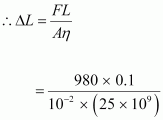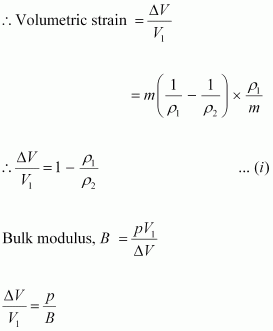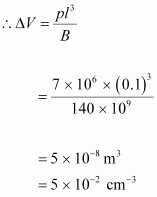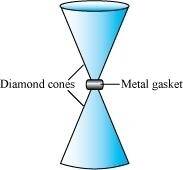Page No 244: - Chapter 9 - Mechanical Properties Of Solids - Ncert Solutions class 11 - Physics
Updated On 26-08-2025 By Lithanya
You can Download the Page No 244: - Chapter 9 - Mechanical Properties Of Solids - Ncert Solutions class 11 - Physics with expert answers for all chapters. Perfect for Tamil & English Medium students to revise the syllabus and score more marks in board exams. Download and share it with your friends
Share this to Friend on WhatsApp
Question 9.6:
The edge of an aluminium cube is 10 cm long. One face of the cube is firmly fixed to a vertical wall. A mass of 100 kg is then attached to the opposite face of the cube. The shear modulus of aluminium is 25 GPa. What is the vertical deflection of this face?
Answer:
Edge of the aluminium cube, L = 10 cm = 0.1 m
The mass attached to the cube, m = 100 kg
Shear modulus (η) of aluminium = 25 GPa = 25 × 109 Pa
Shear modulus, η 
Where,
F = Applied force = mg = 100 × 9.8 = 980 N
A = Area of one of the faces of the cube = 0.1 × 0.1 = 0.01 m2
ΔL = Vertical deflection of the cube

= 3.92 × 10–7 m
The vertical deflection of this face of the cube is 3.92 ×10–7 m.
Question 9.7:
Four identical hollow cylindrical columns of mild steel support a big structure of mass 50,000 kg. The inner and outer radii of each column are 30 cm and 60 cm respectively. Assuming the load distribution to be uniform, calculate the compressional strain of each column.
Answer:
Mass of the big structure, M = 50,000 kg
Inner radius of the column, r = 30 cm = 0.3 m
Outer radius of the column, R = 60 cm = 0.6 m
Young’s modulus of steel, Y = 2 × 1011 Pa
Total force exerted, F = Mg = 50000 × 9.8 N
Stress = Force exerted on a single column  = 122500 N
= 122500 N
Young’s modulus, Y

Where,
Area, A = π (R2 – r2) = π ((0.6)2 – (0.3)2)
 = 7.22 × 10–7
= 7.22 × 10–7
Hence, the compressional strain of each column is 7.22 × 10–7.
Question 9.8:
A piece of copper having a rectangular cross-section of 15.2 mm × 19.1 mm is pulled in tension with 44,500 N force, producing only elastic deformation. Calculate the resulting strain?
Answer:
Length of the piece of copper, l = 19.1 mm = 19.1 × 10–3 m
Breadth of the piece of copper, b = 15.2 mm = 15.2 × 10–3 m
Area of the copper piece:
A = l × b
= 19.1 × 10–3 × 15.2 × 10–3
= 2.9 × 10–4 m2
Tension force applied on the piece of copper, F = 44500 N
Modulus of elasticity of copper, η = 42 × 109 N/m2
Modulus of elasticity, η

= 3.65 × 10–3
Question 9.9:
A steel cable with a radius of 1.5 cm supports a chairlift at a ski area. If the maximum stress is not to exceed 108 N m–2, what is the maximum load the cable can support?
Answer:
Radius of the steel cable, r = 1.5 cm = 0.015 m
Maximum allowable stress = 108 N m–2
Maximum stress = 
∴Maximum force = Maximum stress × Area of cross-section
= 108 × π (0.015)2
= 7.065 × 104 N
Hence, the cable can support the maximum load of 7.065 × 104 N.
Question 9.10:
A rigid bar of mass 15 kg is supported symmetrically by three wires each 2.0 m long. Those at each end are of copper and the middle one is of iron. Determine the ratio of their diameters if each is to have the same tension.
Answer:
The tension force acting on each wire is the same. Thus, the extension in each case is the same. Since the wires are of the same length, the strain will also be the same.
The relation for Young’s modulus is given as:


Where,
F = Tension force
A = Area of cross-section
d = Diameter of the wire
It can be inferred from equation (i) that 
Young’s modulus for iron, Y1 = 190 × 109 Pa
Diameter of the iron wire = d1
Young’s modulus for copper, Y2 = 120 × 109 Pa
Diameter of the copper wire = d2
Therefore, the ratio of their diameters is given as:

Question 9.11:
A 14.5 kg mass, fastened to the end of a steel wire of unstretched length 1.0 m, is whirled in a vertical circle with an angular velocity of 2 rev/s at the bottom of the circle. The cross-sectional area of the wire is 0.065 cm2. Calculate the elongation of the wire when the mass is at the lowest point of its path.
Answer:
Mass, m = 14.5 kg
Length of the steel wire, l = 1.0 m
Angular velocity, ω = 2 rev/s = 2 × 2π rad/s = 12.56 rad/s
Cross-sectional area of the wire, a = 0.065 cm2 = 0.065 × 10-4 m2
Let Δl be the elongation of the wire when the mass is at the lowest point of its path.
When the mass is placed at the position of the vertical circle, the total force on the mass is:
F = mg + mlω2
= 14.5 × 9.8 + 14.5 × 1 × (12.56)2
= 2429.53 N

Young’s modulus for steel = 2 × 1011 Pa

Hence, the elongation of the wire is 1.87 × 10–3 m.
Question 9.12:
Compute the bulk modulus of water from the following data: Initial volume = 100.0 litre, Pressure increase = 100.0 atm (1 atm = 1.013 × 105 Pa), Final volume = 100.5 litre. Compare the bulk modulus of water with that of air (at constant temperature). Explain in simple terms why the ratio is so large.
Answer:
Initial volume, V1 = 100.0l = 100.0 × 10 –3 m3
Final volume, V2 = 100.5 l = 100.5 ×10 –3 m3
Increase in volume, ΔV = V2 – V1 = 0.5 × 10–3 m3
Increase in pressure, Δp = 100.0 atm = 100 × 1.013 × 105 Pa


This ratio is very high because air is more compressible than water.
Question 9.13:
What is the density of water at a depth where pressure is 80.0 atm, given that its density at the surface is 1.03 × 103 kg m–3?
Answer:
Let the given depth be h.
Pressure at the given depth, p = 80.0 atm = 80 × 1.01 × 105 Pa
Density of water at the surface, ρ1 = 1.03 × 103 kg m–3
Let ρ2 be the density of water at the depth h.
Let V1 be the volume of water of mass m at the surface.
Let V2 be the volume of water of mass m at the depth h.
Let ΔV be the change in volume.



For equations (i) and (ii), we get:

Therefore, the density of water at the given depth (h) is 1.034 × 103 kg m–3.
Question 9.14:
Compute the fractional change in volume of a glass slab, when subjected to a hydraulic pressure of 10 atm.
Answer:
Hydraulic pressure exerted on the glass slab, p = 10 atm = 10 × 1.013 × 105 Pa
Bulk modulus of glass, B = 37 × 109 Nm–2

Where,
 = Fractional change in volume
= Fractional change in volume

Hence, the fractional change in the volume of the glass slab is 2.73 × 10–5.
Question 9.15:
Determine the volume contraction of a solid copper cube, 10 cm on an edge, when subjected to a hydraulic pressure of 7.0 ×106 Pa.
Answer:
Length of an edge of the solid copper cube, l = 10 cm = 0.1 m
Hydraulic pressure, p = 7.0 ×106 Pa
Bulk modulus of copper, B = 140 × 109 Pa

Where,
 = Volumetric strain
= Volumetric strain
ΔV = Change in volume
V = Original volume.

Original volume of the cube, V = l3

Therefore, the volume contraction of the solid copper cube is 5 × 10–2 cm–3.
Question 9.16:
How much should the pressure on a litre of water be changed to compress it by 0.10%?
Answer:
Volume of water, V = 1 L
It is given that water is to be compressed by 0.10%.


Therefore, the pressure on water should be 2.2 ×106 Nm–2.
Question 9.17:
Anvils made of single crystals of diamond, with the shape as shown in Fig. 9.14, are used to investigate behaviour of materials under very high pressures. Flat faces at the narrow end of the anvil have a diameter of 0.50 mm, and the wide ends are subjected to a compressional force of 50,000 N. What is the pressure at the tip of the anvil?

Answer:
Diameter of the cones at the narrow ends, d = 0.50 mm = 0.5 × 10–3 m

Compressional force, F = 50000 N
Pressure at the tip of the anvil:

Therefore, the pressure at the tip of the anvil is 2.55 × 1011 Pa.




